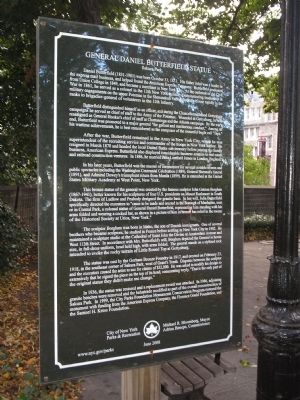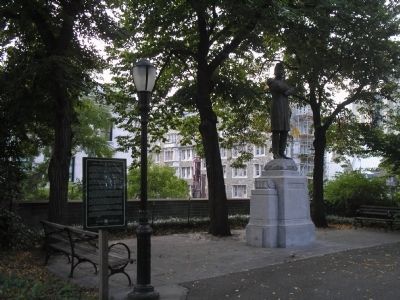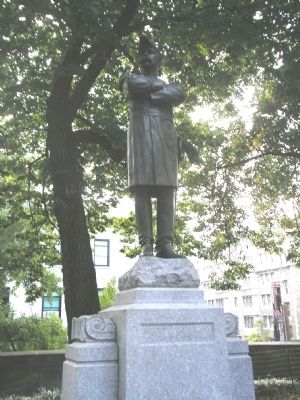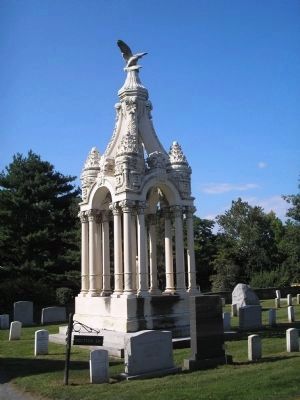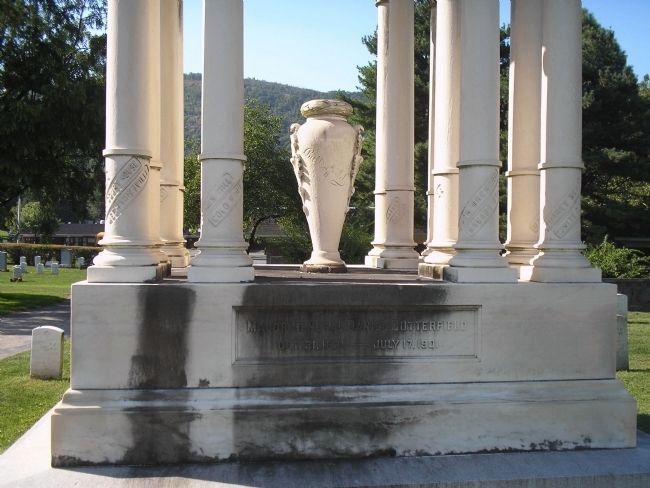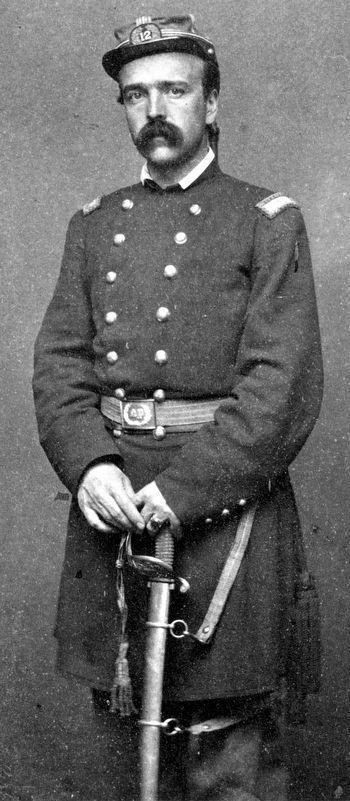Morningside Heights in Manhattan in New York County, New York — The American Northeast (Mid-Atlantic)
General Daniel Butterfield Statue
Sakura Park
Daniel Butterfield (1831-1901) was born October 31, 1831. His father John was a leader in the express mail business, and helped found the American Express Company. Butterfield graduated from Union College in 1849, and became a merchant in New York City. At the outbreak of the Civil War in 1861, he served as a colonel in the 12th New York militia. Demonstrating leadership in military engagements on the upper Potomac in the Shenandoah Valley, Butterfield rose rapidly in the ranks to brigadier-general of volunteers in the 12th Infantry.
Butterfield distinguished himself as an officer, and during the Chancellorsville and Gettysburg campaigns he served as chief of staff to the Army of the Potomac. Wounded at Gettysburg, he was reassigned as General Hooker’s chief of staff at Chattanooga and the Atlanta campaign. By the war’s end, Butterfield was promoted to a major general “for gallant and meritorious conduct.” Among all his wartime achievements, he is best remembered as the composer of the mournful bugle call “Taps.”
After the war, Butterfield remained in the Army in New York City, where he was superintendent of the recruiting service and commander of the troops in New York harbor. He resigned in March 1870 and headed the local United States sub-treasury before joining the family business, American Express. Butterfield also displayed considerable business acumen in real estate and railroad construction ventures. In 1886, he married Julia Lorrilard James in London, England.
In his later years, Butterfield was the master of ceremonies for several notable events and public spectacles including the Washington Centennial Celebration (1889), General Sherman’s funeral (1891), and Admiral Dewey’s triumphant return from Manila (1899). He is entombed at the United States Military Academy at West Point, New York.
This bronze statue of the general was created by the famous sculptor John Gutzon Borglum (1867-1941), better known for his sculptures of four U.S. Presidents on Mount Rushmore in South Dakota. The firm of Ludlow and Peabody designed the granite base. In her will, Julia Butterfield specifically directed the executors to “cause to be made and erected in the Borough of Manhattan, near or in Central Park, a colossal statue of General Daniel Butterfield, representing him standing with his arms folded and wearing a cocked hat, as shown in a picture of him in bronze bas relief in the rooms of the Historical Society at Utica, New York.”
The sculptor Borglum was born in Idaho, the son of Danish immigrants. One of several brothers who became sculptors, he studied in France before settling in New York City in 1902. He maintained a sculpture studio at the Cathedral of Saint John the Divine
at Amsterdam Avenue and West 112th Street. In accordance with Mrs. Butterfield’s will, Borglum depicted the General in heroic size, in full-dress uniform, head held high, with arms folded. The general stands on a stylized rock intended to evoke the rocky terrain of Little Round Top at Gettysburg.
The statue was cast by the Gorgham Bronze Foundry in 1917, and erected on February 23, 1918, in the southeast corner of Sakura Park, west of Grant’s Tomb. Disputes between the sculptor and the executors caused the artist to sue for claims of $32,000. He was asked to modify his design so extensively that he signed the piece on the top of the head, commenting wryly, “That this is the only part of the original statue they didn’t make me change.”
In 1936, the statue was restored and a replacement sword was attached. In 1986, adjoining granite benches were removed and the balustrade modified as part of the overall reconstruction of Sakura Park. In 1999, the City Parks Foundation Monuments Conservation Program restored the monument with funding from the American Express Company, the Florence Gould Foundation, and the Samuel H. Kress Foundation.
Erected 2008 by City of New York Parks & Recreation.
Topics. This historical marker is listed in this topic list: War, US Civil. A significant historical month for this entry is February 1865.
Location. 40° 48.754′ N, 73° 57.733′ W. Marker is in Manhattan, New York, in New York County. It is in Morningside Heights. Marker can be reached from Seminary Row near Claremont Avenue, on the left when traveling east. Touch for map. Marker is in this post office area: New York NY 10027, United States of America. Touch for directions.
Other nearby markers. At least 8 other markers are within walking distance of this marker. Sakura Park (within shouting distance of this marker); General Grant Memorial (within shouting distance of this marker); Horace Porter (about 300 feet away, measured in a direct line); Japanese Lantern (about 400 feet away); a different marker also named Sakura Park (about 400 feet away); Madonna and Child (about 400 feet away); Fred’k D. Grant (about 400 feet away); Four Chaplains Memorial (about 400 feet away). Touch for a list and map of all markers in Manhattan.
Also see . . .
1. Daniel Butterfield. Wikipedia entry (Submitted on September 4, 2021, by Larry Gertner of New York, New York.)
2. General Daniel Butterfield Statue in Sakura Park. New York City Department of Parks & Recreation website. (Submitted on June 4, 2009, by Bill Coughlin of Woodland Park, New Jersey.)
3. General Daniel Butterfield: Tarnished Hero. "Butterfield himself is a perplexing and enigmatic figure whose career deserves close examination." (Submitted on February 12, 2017, by Philip Gilson of Brooklyn, New York.)
4. Major General Daniel Adams Butterfield (USA). (Submitted on February 12, 2017, by Philip Gilson of Brooklyn, New York.)
5. Notes That Tap Deep Emotions. An article by Jari A. Villanueva, about the music for Taps, which was adapted by General Butterfield. (Submitted on February 12, 2017, by Philip Gilson of Brooklyn, New York.)
Credits. This page was last revised on January 31, 2023. It was originally submitted on June 4, 2009, by Bill Coughlin of Woodland Park, New Jersey. This page has been viewed 2,209 times since then and 44 times this year. Photos: 1, 2, 3. submitted on June 4, 2009, by Bill Coughlin of Woodland Park, New Jersey. 4, 5. submitted on September 7, 2009, by Bill Coughlin of Woodland Park, New Jersey. 6. submitted on September 27, 2018, by Allen C. Browne of Silver Spring, Maryland.
